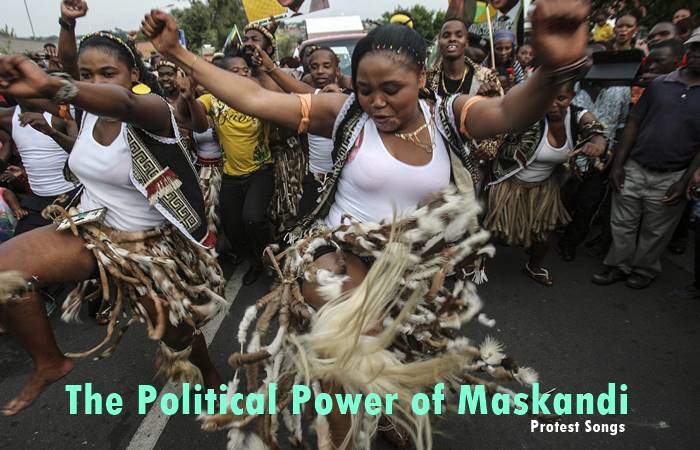
The Political Power of Maskandi: How Zulu Protest Music Shapes South Africa’s Struggle.
Introduction: The Voice of the Marginalized.
Maskandi is more than music—it is the beating heart of Zulu cultural resistance, a living archive of South Africa’s struggles and triumphs. This traditional genre, born from the dust of rural KwaZulu-Natal’s footpaths and the concrete of urban migrant hostels, carries within its guitar strings the weight of history. What began as the songs of wandering minstrels has evolved into one of South Africa’s most potent forms of musical activism, giving voice to those pushed to society’s edges by colonialism, apartheid, and now, by the unfulfilled promises of democracy.
At its core, Maskandi is storytelling set to music—raw, unfiltered, and deeply personal. The lone guitarist singing of love and loss at a rural taxi rank; the migrant worker composing lyrics about exploitation in a Johannesburg mine hostel; the young artist today railing against corruption in Durban’s townships—all are part of an unbroken chain of musical resistance. The genre’s signature sound—crisp guitar picking patterns mimicking Zulu speech rhythms, the haunting melodies echoing traditional amahubo hymns, the poetic izihlabo introductions that set the stage for lyrical storytelling—creates an unmistakable sonic fingerprint that is uniquely South African.
But Maskandi’s true power lies in its dual nature. To the untrained ear, these may sound like simple folk songs—tales of rural life, love gone wrong, or humorous observations. Yet for generations, they have carried coded messages of defiance. During apartheid, when Black political expression was criminalized, Maskandi became what scholar Liz Gunner called “a hidden transcript of resistance”—its metaphors about stubborn cattle or treacherous lovers understood by audiences as critiques of the regime. Today, as South Africa grapples with new forms of oppression—state capture, gender violence, economic exclusion—Maskandi continues to serve as both cultural touchstone and protest art, adapting its centuries-old traditions to 21st century struggles.
ALSO READ: Best Amapiano Songs of 2025 (Mid-Year Roundup)
This article traces Maskandi’s remarkable journey from rural folk tradition to national protest movement. We explore how musicians turned simple guitars into weapons against apartheid, how the genre survived attempts at co-option and commercialization, and how a new generation is reinventing Maskandi for contemporary battles. From Phuzekhemisi’s sly anti-apartheid lyrics to Khuzani’s blistering attacks on corrupt officials, we examine how this “music of the people” remains one of South Africa’s most vital forms of social commentary—proving that resistance, when set to melody, cannot be silenced.
The story of Maskandi is ultimately the story of South Africa itself—a testament to how culture becomes resistance, how tradition fuels revolution, and how the songs of the marginalized eventually shape the nation’s conscience. As we delve into its political evolution, we uncover not just a musical genre, but a living chronicle of South Africa’s ongoing struggle for justice.
1. The Roots of Maskandi: A Brief History
Maskandi, derived from the Zulu word umaskandi (meaning “a wandering minstrel”), traces its origins to the early 20th century among Zulu migrant laborers. These musicians, often self-taught guitarists, were primarily men who traveled between rural homesteads and urban industrial centers, carrying with them not just their instruments but also the stories of their people. The genre emerged as a form of cultural expression for workers displaced by colonial labor systems, particularly those forced into mining and domestic work under harsh conditions.
The music was shaped by the experiences of these migrants—loneliness, exploitation, and the struggle to maintain cultural identity in a rapidly industrializing South Africa. Maskandi artists sang about love, betrayal, ancestral pride, and the daily hardships faced by Black South Africans under oppressive systems. The guitar, introduced by European colonists, became the central instrument, but it was adapted to Zulu musical traditions, creating a unique sound that blended Western folk influences with indigenous rhythms.
Key Characteristics of Maskandi Music
-
Guitar-driven rhythms: The picking style is distinctive, often mimicking the cadence of Zulu speech patterns.
-
Izihlabo (spoken-word introductions): These poetic preludes set the emotional tone of the song, sometimes referencing historical events or personal struggles.
-
Lyrics in isiZulu: Rich in metaphor, proverbs, and social commentary, the language itself became a tool for subtle resistance.
-
Influence from traditional Zulu music: Elements of amahubo (traditional hymns) and ingoma (dance songs) can be heard in Maskandi’s melodic structures.
Early pioneers like Phuzekhemisi, Ihashi Elimhlophe, and Bhekumuzi Luthuli laid the foundation for the genre. Their music was not just entertainment; it was a coded language of survival. Under apartheid, where outright protest could lead to imprisonment or worse, Maskandi musicians used allegory and storytelling to critique the regime without attracting direct retaliation.
2. Maskandi as Protest Music During Apartheid
During apartheid, Black South Africans faced severe restrictions on freedom of speech, assembly, and political organizing. The government censored newspapers, banned political organizations, and imprisoned activists. Yet, Maskandi thrived as a form of resistance precisely because it operated within the realm of “cultural expression,” making it harder for authorities to suppress.
Examples of Anti-Apartheid Maskandi
-
“Wawutshay’ Indoda” by Phuzekhemisi: On the surface, a song about a man standing his ground against adversaries. To listeners, it was an anthem of resilience against apartheid’s brutality.
-
“Amavolovolo” by Ihashi Elimhlophe: Literally about thieves, but understood as a critique of the police force’s violent tactics.
-
“Imbizo” by Bhekumuzi Luthuli: A song that spoke of gatherings (imbizo), which, in context, evoked the banned political meetings of anti-apartheid groups.
These songs avoided censorship by embedding political messages in everyday narratives. The apartheid government, wary of outright banning Zulu cultural music, allowed it to circulate—unaware of its subversive power.
Why Maskandi Survived Repression
-
Oral tradition: Unlike pamphlets or newspapers, Maskandi was passed down through performance, making it difficult to eradicate.
-
Cultural camouflage: Authorities dismissed it as “tribal music,” underestimating its political undertones.
-
Grassroots support: It resonated deeply with rural and working-class Zulu communities, ensuring its survival even when artists faced harassment.
Maskandi became a soundtrack of quiet rebellion, played in shebeens (informal taverns), migrant hostels, and rural gatherings where resistance was nurtured.
3. Post-Apartheid Maskandi: From Struggle to Social Commentary
After 1994, South Africa entered a new era of democracy, but Maskandi did not abandon its role as social critic. Instead, it evolved to address the challenges of the post-apartheid state—corruption, unemployment, and persistent inequality.
New Themes in Modern Maskandi
-
Corruption: Songs like Shwi Nomtekhala’s “Amasheleni” mock politicians who enrich themselves while the poor suffer.
-
Poverty & Unemployment: Artists lament unfulfilled promises of liberation, with lyrics about joblessness and failing public services.
-
Gender-Based Violence: A growing number of Maskandi musicians, including women artists like Nobuhle, now tackle issues like domestic abuse and femicide.
Notable Modern Protest Maskandi Artists
-
Shwi Nomtekhala: Known for sharp critiques of government failures in water and electricity delivery.
-
Mthandeni Manqele (Igcokama Elisha): Addresses crime and social decay in urban townships.
-
Khuzani Mpungose: Blends traditional Maskandi with contemporary themes, calling out political hypocrisy.
While some artists have been co-opted by political parties, many remain fiercely independent, using their platforms to hold power accountable. The genre continues to adapt, with younger musicians experimenting with hip-hop and electronic influences, ensuring its relevance for new generations.
4. Maskandi vs. Hip-Hop: A New Wave of Political Music?
South Africa’s musical landscape has long been a battleground for political expression, with both Maskandi and hip-hop serving as powerful mediums for dissent. While hip-hop artists like Prophets of da City, Zubz, and HHP have used their lyrics to confront systemic injustice head-on, Maskandi offers a distinct form of resistance—one rooted in cultural tradition, linguistic nuance, and deep historical resonance.
Why Maskandi Still Resonates Politically
-
Deep Cultural Roots
Maskandi is more than just music—it is an extension of Zulu oral tradition. Unlike hip-hop, which emerged from global Black urban movements, Maskandi is intrinsically tied to rural South Africa. Its storytelling format, passed down through generations, makes it a trusted voice for older and rural listeners who may not connect with the fast-paced, English-dominated world of hip-hop. -
The Power of IsiZulu
While hip-hop often leans on English or Afrikaans to reach broader audiences, Maskandi’s strength lies in its use of isiZulu. The language carries cultural weight, allowing artists to convey layered messages that resonate deeply in KwaZulu-Natal and beyond. Metaphors, proverbs, and idioms make the lyrics accessible to Zulu-speaking communities while remaining opaque to those outside the culture—a tactic that once helped evade apartheid censors and now allows subtle critiques of modern governance. -
Perceived Authenticity
Unlike commercial hip-hop, which sometimes faces criticism for being co-opted by corporate interests, Maskandi has largely remained independent and grassroots. Its raw, acoustic sound—often just a guitar and voice—gives it an unfiltered honesty that many listeners associate with truth-telling. This authenticity makes it a potent tool for protest, as it is seen as music of the people rather than for mass consumption.
The Blending of Maskandi and Hip-Hop: A New Protest Sound
A fascinating evolution is underway as younger artists fuse Maskandi with hip-hop, creating a hybrid genre that bridges generations.
-
Okmalumkoolkat has experimented with Maskandi-electronica, blending traditional Zulu guitar with modern beats, making the genre more accessible to urban youth.
-
Zulu Meets Rap: Some hip-hop artists, like Big Zulu, incorporate Maskandi elements into their music, ensuring the survival of its protest ethos in new forms.
-
Digital Dissent: Social media platforms like TikTok and YouTube have allowed Maskandi protest songs to reach younger audiences who might not otherwise engage with the genre.
This cross-pollination ensures that Maskandi’s political legacy doesn’t fade but instead adapts to new forms of resistance.
5. The Future: Can Maskandi Remain a Tool for Change?
Despite its enduring power, Maskandi faces significant challenges that threaten its role as a voice of resistance.
Threats to Maskandi’s Protest Legacy
-
Commercialization
As Maskandi gains mainstream popularity, some artists are diluting its political edge to secure radio play and corporate sponsorships. Songs that once critiqued corruption now focus on love and party themes to appeal to broader audiences. -
Language Barriers
Younger, urban listeners—raised on global hip-hop and Afrobeats—often prefer music in English or slang-heavy vernaculars. While Maskandi’s isiZulu lyrics are its strength, they also limit its reach among non-Zulu-speaking youth. -
Government Co-option
Some politicians and parties have attempted to neutralize Maskandi’s criticism by financially supporting artists who avoid controversial topics. This patronage system risks turning the genre into a propaganda tool rather than a medium of dissent.
Hope for the Future: New Voices and Digital Resistance
Despite these threats, Maskandi’s protest spirit persists.
-
Independent Artists: Musicians like Khuzani Mpungose continue to release politically charged tracks, refusing to be silenced by commercial pressures.
-
Women in Maskandi: Female artists, traditionally marginalized in the genre, are now using it to challenge patriarchy and gender-based violence, expanding its scope of activism.
-
Digital Platforms: YouTube, Spotify, and social media allow Maskandi to bypass traditional gatekeepers, reaching global audiences without sacrificing its message.
ALSO READ: Tyla Features on Sabrina Carpenter’s Netflix Special, ‘A Nonsense Christmas’
The Unbroken Spirit of Maskandi Resistance
From the migrant labor camps of apartheid to the digital age of #FeesMustFall, Maskandi has remained South Africa’s musical conscience. It has adapted—absorbing new influences, confronting new injustices—but never losing its core identity as a soundtrack of struggle.
As long as inequality, corruption, and oppression persist, Maskandi will continue to strum the chords of resistance, ensuring that the voices of the marginalized are never silenced.
Which Maskandi protest song speaks to you? Share your thoughts in the comments!







 Pabi Moloi Returns to Television as Host of New Reality Series ‘The Insurance Apprentice’ on SABC3
Pabi Moloi Returns to Television as Host of New Reality Series ‘The Insurance Apprentice’ on SABC3  DJ Maphorisa and Shaun 101 Caught In Heated Club Spat As Video Goes Viral [Watch]
DJ Maphorisa and Shaun 101 Caught In Heated Club Spat As Video Goes Viral [Watch]  Mamelodi Sundowns to Offload Fan-Favourite Thembinkosi Lorch to North African Giants
Mamelodi Sundowns to Offload Fan-Favourite Thembinkosi Lorch to North African Giants  Judiciary Demands Evidence from Nhlanhla Mkhwanazi Over Explosive Corruption Allegations
Judiciary Demands Evidence from Nhlanhla Mkhwanazi Over Explosive Corruption Allegations  Orlando Pirates Jersey Numbers 11 and 15 Handed to New Signings Ahead of 2025/26 Season
Orlando Pirates Jersey Numbers 11 and 15 Handed to New Signings Ahead of 2025/26 Season